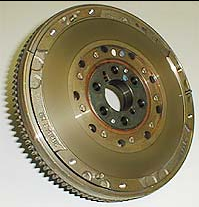What is a flywheel?
A flywheel used in machines acts as a reservoir to store energy when the supply of energy is excess and the same is released when the requirement arises i.e. its primary function is to sort out variations in the speed of a shaft which are caused due to torque fluctuations.
In case of I.C engines, energy is developed during power stroke and the engine is to run the whole cycle from the power generated from this stroke. When the flywheel absorbs energy, its speed goes on increasing and when it releases the acquired energy, it decreases.

Image source: Wiki
Classification of fly wheel
Based on the mode of operation, two kinds of flywheel designs are there:
- Disc type – Suited for smaller sized engines/machines
- Arm type – Suited for larger sized engines/machines
Application of flywheels
Fundamental Principles of Flywheel Design and Sizing Calculations
Firstly, calculate the mass moment of inertia required by the flywheel to smoothing out the fluctuation/variations of kinetic energy in the system. This will be discussed in this article.
Secondly, calculate the geometry/dimensions of the flywheel based on the calculated mass moment of inertia and material properties. This will be covered in another article.
Design steps and formulas
Step-1: Coefficient of fluctuation calculation
Input required: Maximum & minimum speed
Flywheel inertia/size depends upon the fluctuations in speed. The difference between maximum & minimum speeds during a cycle is called maximum fluctuation of speed.
The ratio between maximum fluctuations of speed to mean speed is called coefficient of fluctuation of speed (Cs).
Consider, Ѡ max =Max. Speed during the cycle
Ѡmin = Min. speed during the cycle
Ѡmean =Mean speed = (Ѡ max + Ѡ min) /2…….eq.1
Therefore, Coefficient of Fluctuation of speed,
Cs = [2*(Ѡmax–Ѡmin)]/[Ѡmax+Ѡmin]…….eq.2
Note: The smaller the Cs value, larger the flywheel, but smoother the operation.
Step-2: Mass moment of inertia calculation
Input required: kinetic energy of the system
The general equation of kinetic energy for a flywheel system is given as,
Ke = 0.5* I* (Ѡmax2 – Ѡmin2) ………..eq.3
Rewriting eq.3, we get
Ke = 0.5 I (Ѡmax + Ѡmin) (Ѡmax – Ѡmin)…………eq.4
Substituting eq.1 & 2 in eq.4, we get
I = Ke / Cs Ѡmean2……………..eq.5
eq.5 is used to obtain necessary flywheel inertia corresponding to variations in speed.
We will try out a simplified problem on flywheel sizing and calculate the required moment of inertia.
Regarding units ( Important ):
Ke – N.m
Ѡ – rad/sec
I – Kg.m2
Example:
Let us consider a punching machine driven by 3KW, 1000RPM powered motor with a gear set of 5:1 and a stroke length of 250mm. Rated capacity of the punching machine is 22KN.
Consider coeff. of fluctuation of speed, Cs = 0.02 (Value to be considered by the designer)
Since it is a small machine, diameter of the flywheel should be as small as possible.
Consider 500mm to be the max size of the flywheel dia.
Calculate the mass moment of inertia required for the flywheel of the punching press machine.
Solution:
Step-1: Coefficient of fluctuation (Cs) calculation
The value is given as,
Cs=0.02
Step-2: Mass moment of inertia (I) calculation
Input required: kinetic energy of the system- to be calculated
Kinetic energy of the system (Ke) calculation:
Work done, W = 22*10^3*0.25*0.15 (Assume rated load delivered during 15% of power stroke)
Therefore, W = 825Nm
Thus, Energy absorbed is 825Nm.
Now, let us calculate the mean torque acting on the shaft, Tmean = 3*10^3 / 2*π*(1000/60)
Therefore, Tmean = 28.66Nm
Work done per cycle is (Energy supplied), Wc= 2π*28.66*5 = 900 Nm
Therefore, Kinetic energy of the system is,
Ke=W–Wc*0.08 (Energy absorbed – Energy supplied* factor for loss)
Ke = 825 – 900 *0.08 (0.08 – factor for losses. Again dependent on the designer)
Ke = 753Nm
Therefore, mass moment of inertia as per eq.5 is
I = 753 / 0.02 (2π*1000/60)2
I = 3.43 Kg.m2
Hence, the flywheel sizing/design calculation for the above example shows that the required mass moment of inertia for this application should be = 3.43 Kg.m2.

how do you choose loss factor as 0.08? Is there any tables or specifications or standards? please explain